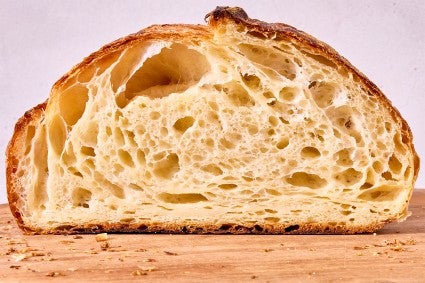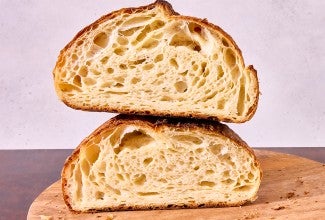Is the viral croissant sourdough bread worth the hype?
Turns out adding a lot of butter to your bread is a great decision.


“Where has this been all my life?” asks Amy Coyne of @amy.bakes.bread in an Instagram reel viewed by over 11 million people. She’s talking about her croissant sourdough bread, a loaf with a crispy, flaky crust and feathery crumb that suddenly appeared and took social media by storm.
It’s likely you’ve already seen this loaf pop up on your own algorithm, but in case you’re not familiar, it’s made by incorporating grated cold butter — anywhere from one to three sticks — into sourdough bread dough before shaping and baking. The results are said to be a mashup of a croissant’s buttery, flaky layers and sourdough’s chewy interior and crunchy exterior. But is it actually worth baking, or is it just another internet stunt?
That’s what King Arthur Test Kitchen Manager Sarah Jampel wondered. So she put it to an initial test, grating half a stick of butter into our Extra-Tangy Sourdough Bread. “I was very skeptical of the entire idea, but it worked really well,” she reported. “The bread was super soft and buttery inside, with a soft, pull-apart quality that was reminiscent of a croissant.” (Sarah’s no stranger to croissant-inspired breads: She previously developed this gorgeous, sliceable Big and Buttery Croissant Bread.)
Inspired by this initial success, Martin Philip (coauthor of our bestselling new cookbook, The Big Book of Bread) went on to develop a recipe for Croissant Sourdough Bread, using the basic template of grating butter into bread dough as a springboard for our take on it. He added an egg yolk to the dough for added richness and to give the bread a softer, silkier texture, plus a more yellow color to represent the butteriness of a croissant. He also incorporated a preferment and an extended fermentation timeline so the bread would have plenty of time to develop flavor. The result is a gorgeous loaf with the buttery flavor and soft flakiness of a croissant — one very much worth its fame.

A healthy starter is key. If your starter has been languishing in the fridge for a week or missed a couple of recent feedings, we recommend feeding it twice a day at room temp until it triples in volume in about 4 hours when fed with a 1:1:1 ratio (i.e., equal parts water, flour, and starter by weight). Now you’re ready to bake this loaf!
For strong, supple dough, use bread flour. With its higher protein content, bread flour supports gluten development. That’s especially key here, as the dough needs to be stretched and laminated with butter — bread flour provides both the elasticity and extensibility required for this step.
Most importantly, be mindful of temperature! Similar to making pie crust or biscuits, you want the butter to stay solid in the dough so that as it bakes, the melting butter releases steam, creating buttery pockets and flaky layers. After laminating the dough with butter, don’t place it in an environment that’s above 80°F, as the butter will melt and leak out.
Watch the bottom of the loaf during baking. Because of the high butter content, the bottom of the loaf may get quite brown while baking. Check the color during the second half of the bake time; if it's becoming too brown, slide a second piece of parchment underneath.
Cover photo by Patrick Marinello; food styling by Yekaterina Boytsova.


